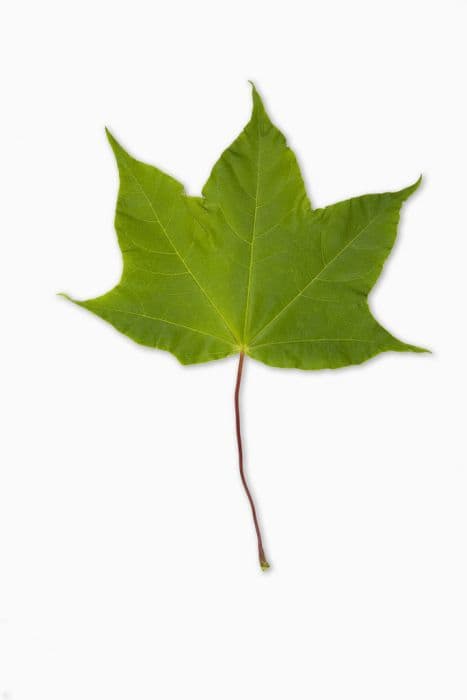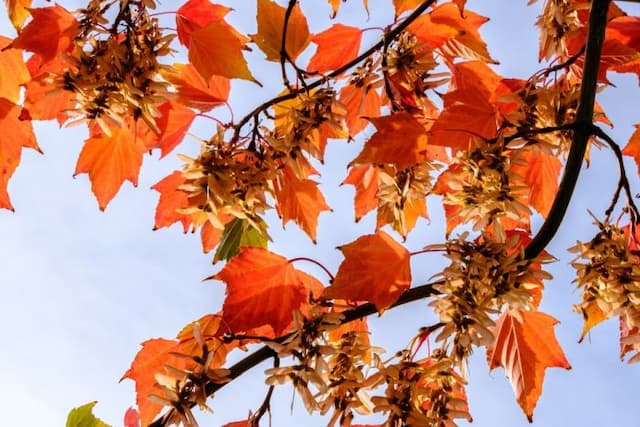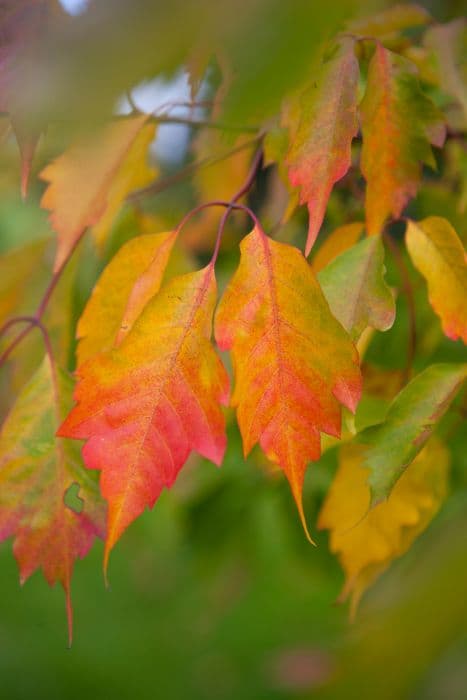Vine Maple Acer micranthum

ABOUT
Acer micranthum, commonly known as the small-leaf maple, is characterized by its distinctive foliage and overall form. The leaves of this maple tree are its most recognizable feature, being significantly smaller compared to other maple species. They have a classic maple shape, which includes the typical lobes and sinuses, and they are arranged opposite each other on the stems. Each leaf exhibits a rich green hue that may turn to vibrant colors in the autumn, ranging from brilliant yellows to deep reds, which makes the small-leaf maple particularly appreciated for its fall display. The bark of the small-leaf maple has a subtle color and texture that becomes slightly rougher as the tree matures. The branches of this maple spread outwards, creating an aesthetically pleasing canopy that is dense with foliage. During the flowering season, the small-leaf maple produces modest flowers that, while not particularly showy, add to the overall appearance of the plant. These are followed by the familiar winged seeds, known as samaras, which helicopter down from the branches when they ripen and disperse with the wind. Overall, the small-leaf maple is known for its ornamental qualities, as it presents a harmonious combination of leaf shape, seasonal color variation, bark texture, and an attractive overall silhouette. This makes it a favorite in gardens and parks, where it is often used for its decorative appeal rather than its size.
About this plant
 Names
NamesFamily
Sapindaceae
Synonyms
Vine-leaf Maple, Small-leaved Maple
Common names
Acer micranthum
 Toxicity
ToxicityTo humans
Acer micranthum, commonly known as maple, does not have a well-documented toxicity profile concerning human ingestion. Most maple species are not known to be toxic to humans, and there is no significant evidence to suggest that Acer micranthum is an exception. However, as with any plant, individual allergies or sensitivities can occur. In general, it is advisable to avoid ingesting parts of ornamental plants not confirmed as edible due to potential unknown risks or individual reactions.
To pets
Acer micranthum, commonly known as maple, is not typically listed as a toxic plant to pets such as dogs and cats. However, some maples, specifically red maples (Acer rubrum), can be toxic to pets, especially horses, if they ingest wilted or dried leaves, leading to a condition known as red maple leaf poisoning. Symptoms in horses can include lethargy, dark brown urine, increased heart and respiratory rates, and jaundice. While Acer micranthum is not Acer rubrum, pet owners should generally exercise caution and prevent pets from consuming plants that are not known to be safe. If you suspect your pet has ingested a potentially toxic plant, it is important to contact your veterinarian immediately.
 Characteristics
CharacteristicsLife cycle
Perennials
Foliage type
Deciduous
Color of leaves
Green
Flower color
Yellow
Height
15-25 feet (4.6-7.6 meters)
Spread
10-20 feet (3-6 meters)
Plant type
Tree
Hardiness zones
5
Native area
Japan
Benefits
 General Benefits
General Benefits- Aesthetic value: Acer micranthum, commonly known as the Vine-leaf Maple, is valued for its ornamental qualities, such as its delicate leaves and attractive autumn foliage.
- Habitat support: It provides habitat and food for wildlife such as birds and insects, which feed on its seeds and find shelter in its branches.
- Shade provision: The canopy of the Vine-leaf Maple offers shade, creating cooler microclimates beneath it, which can be beneficial in landscaped areas and gardens.
- Soil stabilization: The root system of Acer micranthum helps prevent soil erosion, especially in sloped areas or where ground cover is needed.
- Wood production: Although not a major timber species, the wood of Vine-leaf Maple can be used for small woodworking projects, turning, and sometimes for ornamental purposes.
 Medical Properties
Medical PropertiesThis plant is not used for medical purposes.
 Air-purifying Qualities
Air-purifying QualitiesThis plant is not specifically known for air purifying qualities.
 Other Uses
Other Uses- Acer micranthum, known as the vine maple, can be used for woodturning projects, as its wood is fine-grained and can be turned into objects such as bowls, spindles, and pens.
- The wood from vine maple is also suitable for making musical instruments like flutes or woodwind instruments due to its hardness and ability to be finely shaped.
- Landscape design can utilize vine maple for bonsai cultivation because of its small leaves and attractive branching patterns when appropriately pruned.
- In small-scale furniture making, vine maple's wood can be used for crafting decorative inlays, offering a subtle contrast to darker woods.
- The wood of vine maple, being quite sturdy, can also be fashioned into durable wooden tool handles for garden or woodworking tools.
- Native crafting traditions may use the wood or bark of vine maple to create woven goods, such as baskets, due to its flexibility when young and heated.
- The vine maple's springy wood qualities make it good for making wooden toys such as bows, arrows, or even simple kinetic toys for children.
- The distinctive winged seeds of vine maple can be incorporated into jewelry designs or as decorative elements in crafts due to their unique shape.
- In educational settings, vine maple can serve as an excellent species for teaching about native plants, forest ecology, and the role of understory trees in woodland environments.
- During autumn, fallen leaves from vine maple can be collected and used as a natural dye for fabrics, providing shades of yellow and brown.
Interesting Facts
 Feng Shui
Feng ShuiThe Acer micranthum, commonly known as the Miyama maple, is not used in Feng Shui practice.
 Zodiac Sign Compitability
Zodiac Sign CompitabilityThe Miyama maple is not used in astrology practice.
 Plant Symbolism
Plant Symbolism- Resilience: Acer micranthum, common name "Kyushu Maple," like many maple trees, symbolizes resilience for its ability to withstand a range of conditions and climates.
- Adaptability: Its capacity to grow in various environments also lends itself as a symbol of adaptability, thriving in changing circumstances.
- Beauty: The aesthetic appeal of its leaves, especially during autumn, signifies beauty and appreciation for the natural world.
- Strength: As a tree that stands firm through seasons, the Kyushu Maple represents strength and steadfastness.
- Peace: The tranquil appearance of the tree's canopy brings a sense of peace and calm, commonly associated with trees and forests.
 Water
WaterThe Vine Maple requires consistent moisture, so it's important to water it deeply once a week. During hot or dry weather, water the tree two to three times per week. Provide the tree with around 2 gallons of water at each watering, ensuring you wet the soil thoroughly but avoiding waterlogging. During winter, reduce watering as the tree requires less moisture.
 Light
LightVine Maples thrive in partial shade to full sun, but they prefer dappled sunlight or afternoon shade, as this mimics their natural understory habitat. An ideal spot would be where the tree is protected from the harsh midday sun, which can scorch its leaves, especially in summer.
 Temperature
TemperatureThe Vine Maple is hardy and adaptable, tolerating temperatures as low as -10 degrees Fahrenheit and as high as 90 degrees Fahrenheit. The ideal temperature range for this tree is between 60 and 75 degrees Fahrenheit, which encourages healthy growth.
 Pruning
PruningPruning the Vine Maple is needed to remove dead or diseased branches, improve structure, and encourage new growth. The best time to prune is late winter or early spring before new growth starts. Prune sparingly, only when necessary, to maintain the tree's natural shape.
 Cleaning
CleaningAs needed
 Soil
SoilThe best soil mix for Acer micranthum, commonly known as Miyama maple, is well-draining, moderately fertile, and consistently moist. An ideal mixture could be equal parts loamy garden soil, peat, and perlite to ensure good drainage and aeration. The preferred soil pH for Miyama maple is slightly acidic to neutral, ranging from 5.5 to 7.5.
 Repotting
RepottingMiyama maple (Acer micranthum) typically requires repotting every 2-3 years, depending on the growth rate and pot size. Younger trees grow more rapidly and may need to be repotted more often to accommodate their developing root systems. It is best to repot during dormancy in late winter or early spring before new growth begins.
 Humidity & Misting
Humidity & MistingMiyama maple (Acer micranthum) thrives best in environments with moderate to high humidity levels. Aim to maintain humidity around 60-80% for optimal growth conditions. Avoid placing it in very dry environments, as this could adversely affect its health and leaf condition.
 Suitable locations
Suitable locationsIndoor
Bright, indirect light, and keep soil evenly moist.
Outdoor
Plant in dappled sun, shelter from harsh winds, moist soil.
Hardiness zone
5-7 USDA
 Life cycle
Life cycleAcer micranthum, commonly known as Vine Maple, begins its life cycle as a seed, which requires stratification through a cold period to break dormancy. Once germinated, the seedling establishes itself and begins to grow leaves and roots, entering a juvenile phase where it gradually matures into an adult plant. As an adult, the Vine Maple develops a woody stem and branches, and during the reproductive stage, it produces small, inconspicuous flowers followed by winged fruits called samaras that disperse with the wind. The plant goes through an annual cycle of leaf growth in the spring, followed by a phase of energy storage in the summer, and leaf senescence in the autumn, where leaves turn vivid colors and fall off. During winter dormancy, biological processes slow down, conserving energy for the next growth season. This cycle repeats annually with the mature Vine Maple capable of living for several decades, depending on environmental conditions.
 Propogation
PropogationPropogation time
Spring-early summer
Propogation: The most popular method of propagation for Acer micranthum, commonly known as the Vine Maple, is by seed. To ensure successful germination, the seeds of Vine Maple should be cold stratified. This is done by mixing the seeds with moist sand and storing them in a refrigerator at around 34 to 40 degrees Fahrenheit (1 to 4 degrees Celsius) for 90 to 120 days. After this period, the seeds can be sown in a well-draining soil mix, covering them lightly. The best time to start this process is in early spring, which allows the seeds to establish in a controlled environment before the growing season. Seedlings require protection from harsh direct sunlight and should be kept consistently moist until they are strong enough for transplanting.









